Related Research Articles

The Ramayana is a smriti text from ancient India, one of the two important epics of Hinduism known as the Itihasas, the other being the Mahabharata. The epic, traditionally ascribed to the Maharishi Valmiki, narrates the life of Rama, a prince of Ayodhya in the kingdom of Kosala. The epic follows his fourteen-year exile to the forest urged by his father King Dasharatha, on the request of Rama's stepmother Kaikeyi; his travels across forests in the Indian subcontinent with his wife Sita and brother Lakshmana; the kidnapping of Sita by Ravana, the king of Lanka, that resulted in war; and Rama's eventual return to Ayodhya along with Sita to be crowned king amidst jubilation and celebration.

Ravana is a multi-headed rakshasa king of the island of Lanka, and the chief antagonist in the Hindu epic Ramayana. In the Ramayana, Ravana is described as the eldest son of sage Vishrava and Kaikasi. He abducted Prince Rama's wife, Sita, and took her to his kingdom of Lanka, where he held her in the Ashoka Vatika. Rama, with the support of vanara King Sugriva and his army of vanaras, launched an invasion against Ravana in Lanka. Ravana was subsequently slain, and Rama rescued his beloved wife Sita.
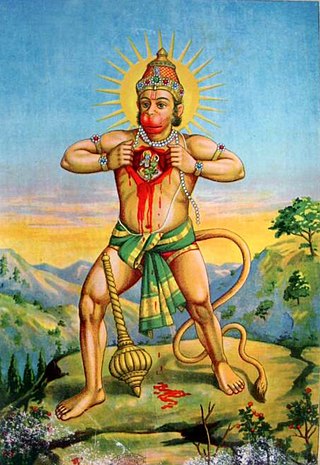
Hanuman, also known as Maruti, Bajrangabali, and Anjaneya, is a deity in Hinduism, revered as an avatar of Shiva, divine vanara, and a devoted companion of the deity Rama. Central to the Ramayana, Hanuman is celebrated for his unwavering devotion to Rama and is considered a chiranjivi. He is traditionally believed to be the spiritual offspring of the wind deity Vayu, who is said to have played a significant role in his birth. His tales are recounted not only in the Ramayana but also in the Mahabharata and various Puranas.
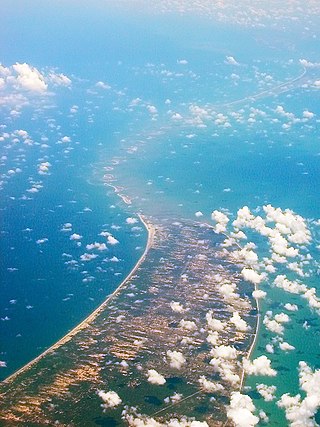
Adam's Bridge, also known as Rama's Bridge or Rama Setu, is a chain of natural limestone shoals between Pamban Island, also known as Rameswaram Island, off the south-eastern coast of Tamil Nadu, India, and Mannar Island, off the north-western coast of Sri Lanka. Geological evidence suggests that the bridge was formerly a land connection between India and Sri Lanka.
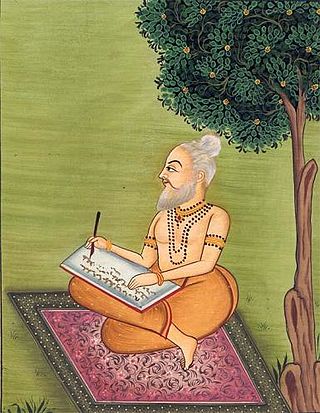
Maharishi Valmiki was a legendary poet who is celebrated as the traditional author of the epic Ramayana, based on the attribution in the text itself. He is revered as Ādi Kavi, the first poet, author of Ramayana, the first epic poem.
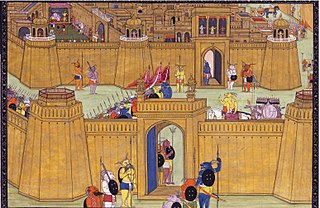
Lanka is the name given in Hindu epics to the island fortress capital of the legendary asura king Ravana in the epics of the Ramayana and the Mahabharata. The fortress was situated on a plateau between three mountain peaks known as the Trikuta Mountains. The ancient city of Lankapura is said to have been burnt down by Hanuman. After its king, Ravana was killed by Rama with the help of Ravana's brother Vibhishana, the latter was crowned king of Lankapura. His descendants were said to still rule the kingdom during the period of the Pandavas. According to the Mahabharata, the Pandava Sahadeva visited this kingdom during his southern military campaign for the rajasuya of Yudhishthira. The palaces of Ravana were said to be guarded by four-tusked elephants.

Shatrughna is a prince of Ayodhya, King of Madhupura and Vidisha, and a brother of Prince Rama in the Hindu epic Ramayana. He is also known as Ripudaman. He is the twin of Lakshmana. He is a loyalist of Bharata, just like Lakshmana is to Rama. According to the Valmiki Ramayana, Shatrughna is an incarnation of the Sudarshana Chakra. Shatrughna also appears as the 412th name of Vishnu in the Vishnu Sahasranama of the Mahabharata.
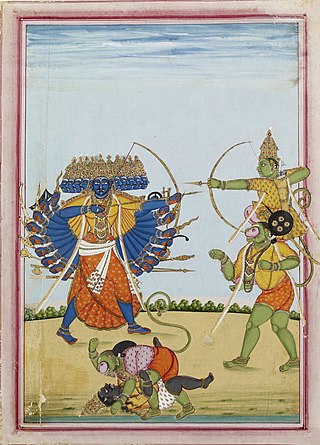
The Ramavataram, popularly referred to as Kamba Ramayanam, is a Tamil epic that was written by the Tamil poet Kambar during the 12th century. Based on Valmiki's Ramayana, the story describes the legend of King Rama of Ayodhya. However, the Ramavataram is different from the Sanskrit version in many aspects – both in spiritual concepts and in the specifics of the storyline. This historic work is considered by both Tamil scholars and the general public as one of the greatest literary works in Tamil literature.

Kakawin Ramayana is an Old Javanese poem rendering of the Sanskrit Ramayana in kakawin meter.

Sita, also known as Siya, Janaki, Maithili, Vaidehi and Bhumija, is a Hindu goddess and the female protagonist of the Hindu epic, Ramayana. She is the consort of Rama, the avatar of the god Vishnu, and is regarded as a form of Vishnu's consort, Lakshmi. She is also the chief goddess of Rama-centric Hindu traditions. Sita is known for her dedication, self-sacrifice, courage, and purity.

Yama Zatdaw, unofficially Myanmar's national epic, is the Burmese version of the Ramayana and Dasaratha Jataka. There are nine known pieces of the Yama Zatdaw in Myanmar. The Burmese name for the story itself is Yamayana, while zatdaw refers to the acted play or being part of jataka tales of Theravada Buddhism.

Jatayu is a demigod in the Hindu epic Ramayana, who has the form of either an eagle or a vulture. He was the younger son of Aruṇa and his wife Shyeni, the brother of Sampati, as well as the nephew of Garuda. He was also an old friend of King Dasharatha, Rama's father.

Bharata is a figure in the ancient Hindu epic Ramayana. He is the son of Dasharatha, the king of Kosala, and Kaikeyi, the daughter of King Ashvapati of Kekeya. He is a younger half-brother of Rama. He rules Ayodhya as its regent while Rama is banished from his kingdom, and fights to rescue his wife Sita, kidnapped by Ravana.

Adhyatma Ramayana is a 13th- to 15th-century Sanskrit text that allegorically interprets the story of Hindu epic Ramayana in the Advaita Vedanta framework. It is embedded in the latter portion of Brahmānda Purana, and the author is considered to be Vyasa. The Hindu tradition also attributes the text to the Bhakti movement saint Ramananda.
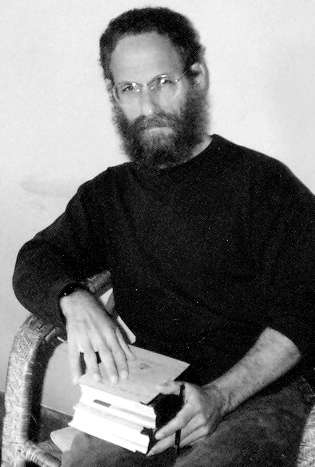
Sheldon I. Pollock is an American scholar of Sanskrit, the intellectual and literary history of India, and comparative intellectual history. He is the Arvind Raghunathan Professor of South Asian Studies at Columbia University. He was the general editor of the Clay Sanskrit Library and the founding editor of the Murty Classical Library of India.

Ramayana: The Legend of Prince Rama is a 1992 anime film co-produced by Japan and India; produced and directed by Yugo Sako. It is based on the Indian epic Ramayana. The film was directed by Koichi Sasaki and Ram Mohan, with music composed by Vanraj Bhatia. Although it was banned in India during the Babri Masjid riots, it was later dubbed in Hindi and aired on DD National.

Depending on the methods of counting, as many as three hundred versions of the Indian Hindu epic poem, the Ramayana, are known to exist. The oldest version is generally recognized to be the Sanskrit version attributed to the sage Narada, the Mula Ramayana. Narada passed on the knowledge to Valmiki, who authored Valmiki Ramayana, the present oldest available version of Ramayana.
Kṛttivāsī Rāmāyaṇ,; also called Śrīrām Pãcālī, composed by the fifteenth-century Bengali poet Krittibas Ojha, from whom it takes its name, is a rendition of the Rāmāyaṇa into Bengali. Written in the traditional Rāmāyaṇa Pā̃cālī form of Middle Bengali literature, the Kṛttivāsī Rāmāyaṇ is not just a rewording of the original Indian epic, but also a vivid reflection of the society and culture of Bengal across the period of its circulation, from the Middle Ages into the modern period. It was characterised by Dinesh Chandra Sen in 1911 as 'by far the most popular book in Bengal' and 'the Bible of the people of the Gangetic Valley'.
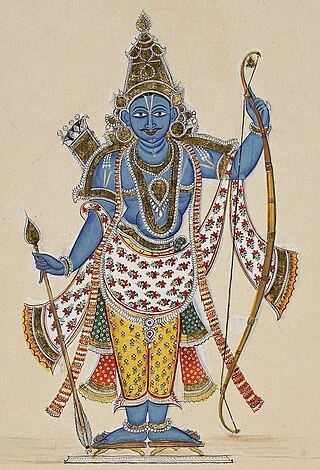
Rama is a major deity in Hinduism. He is the seventh and one of the most popular avatars of Vishnu. In Rama-centric traditions of Hinduism, he is considered the Supreme Being.
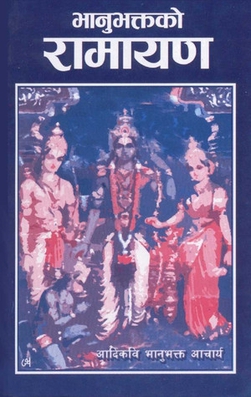
Bhanubhakta Ramayana, commonly known as Ramayan, is the Nepali translation of Valmiki Ramayana by Adikavi Bhanubhakta Acharya. It was posthumously published in its complete form in 1887. It is widely considered to be the first Nepali epic. The prose style of the epic has been termed Bhanubhaktiya Laya since it was completely original in Nepali literature, being the first work. Due to this distinction, the author, poet Bhanubhakta Acharya is known as Adikavi in Nepal.